Untitled Document

In recent years, environmental health science has broadened the scope of its inquiries,
expanding its investigations beyond the effects of single pollutants on individuals
to incorporate the entire panorama of external factors that may affect people's
health. Consideration of the health impacts of the built environment - the human-modified
places where we live, work, play, shop, and more - has been a key element in the
ongoing evolution of the field of environmental health.
Substantial scientific evidence gained in the past decade has shown that various
aspects of the built environment can have profound, directly measurable effects
on both physical and mental health outcomes, particularly adding to the burden
of illness among ethnic minority populations and low-income communities. Lack
of sidewalks, bike paths, and recreational areas in some communities discourages
physical activity and contributes to obesity; in those low-income areas that
do have such amenities, the threat of crime keeps many people inside. Income
segregation - the practice of housing the poor in discrete areas of a city -
has also been linked with obesity and adverse mental health outcomes. Lack of
a supermarket in a neighborhood limits residents' access to healthy foods. Dilapidated
housing is associated with exposures to lead, asthma triggers (such as mold,
moisture, dust mites, and rodents), and mental health stressors such as violence
and social isolation.
More recently, the field has begun to take an even wider-angle view, as investigators
have begun using innovative new tools and approaches to explore the multifaceted
interrelationships between the built environment and population-level health
outcomes. It has become increasingly clear that the built environment not only
directly impacts our health, but also factors in less direct, complex ways into
the health of individuals residing in single-family homes, housing projects,
blocks, neighborhoods, and entire cities.
Low-income and/or ethnic minority communities - already burdened with greater
rates of disease, limited access to health care, and other health disparities
- are also the populations living with the worst built environment conditions.
Studies have shown that negative aspects of the built environment tend to interact
with and magnify health disparities, compounding already distressing conditions.
Elucidating the associations between the built environment and health disparities
has proven to be an enormous challenge to the scientific community, requiring
the development of new research paradigms, hypotheses, and methodologies. Traditional
studies have often lumped many important components of the built environment
into a blanket socioeconomic status variable. But this approach makes it nearly
impossible to tease out specific housing and community characteristics related
to disease. So, although the traditional tools of environmental health science
are still an important part of the mix, research endeavors in this area are
now incorporating aspects of sociology, psychology, demography, urban planning,
and architecture. Just as significantly, research efforts are reaching beyond
the boundaries of the scientific community, embracing rapid translation of research
into effective intervention and active collaboration with community members
as central concepts in their research protocols.
Space: The Data Frontier
Spatial analysis is one of the new tools being applied in attempts to quantify
the relationship between health disparities and the built environment. One spatial
analysis tool, geographic information system (GIS) technology, has long been
in use in other areas such as city planning, demography, and epidemiology, but
is now allowing environmental and public health researchers to characterize
local environments at finely resolved geographic scales. More complete, accurate,
and comprehensive geocoded data on resources within communities are becoming
increasingly available from a growing number of sources such as governmental
agencies, law enforcement agencies, and marketing researchers. This allows researchers
studying the built environment to look at communities in new ways.
"The use of GIS technology allows researchers to look at the density
and proximity of goods, services, and community resources such as parks, youth
clubs, fast food outlets, convenience stores, and other factors that might enhance
or hinder health, in relationship to where people live and work," says
Marilyn Winkleby, an associate professor of medicine at the Stanford Prevention
Research Center. "GIS provides the technology to spatially display, synthesize,
and analyze data - it creates a dynamic visual understanding of people, places,
and health."
As part of a larger project examining neighborhood-level influences on mortality
from all causes, Winkleby and her colleagues are preparing to publish results
from two studies using GIS to link survey data with other information such as
census data, health records, and site visits. Both studies suggest pathways
by which disparities in the built environment can be related to disparities
in health.
The first study showed that, of 82 neighborhoods studied in four northern/central
California cities, the most deprived neighborhoods contained more places that
sold alcohol than the least deprived neighborhoods, despite the fact that residents
of the higher-SES neighborhoods were the most likely to be heavy drinkers. Winkleby
cites this disproportionate clustering in low-income neighborhoods - with its
documented sequelae of greater injuries and violence due to increased rates
of youth drinking and driving, assault, and car crashes - as one example of
why it's important to examine the built environment in addition to individual
risk factors when studying health disparities.
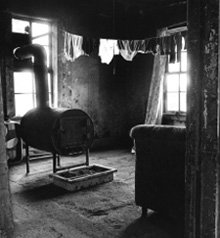
Home, bitter home? Tradition holds that home is a haven where
people are protected and nurtured. For many, however, home is a health hazard
when factors such as poverty, environmental contamination and poor design combine
to cause or exacerbate disease.
(Photo: Alvaro Leiva / Panos Pictures)
Interestingly, the other study found that another characteristic of the physical
environment in the deprived neighborhoods influenced an individual risk factor.
"Higher convenience store concentrations - whether measured by density,
distance, or number of convenience stores within a one-mile radius of participants'
households - are significantly associated with higher levels of individual smoking,"
says Winkleby.
Marie Lynn Miranda, director of the Children's Environmental Health Initiative
(CEHI) at Duke University, says the use of spatial analysis allows her center
to more effectively quantify associations between the built environment and
health outcomes. "You can create variables of interest and structure them
according to what people tell you is the space of interest to them [such as
individual homes or unique neighborhoods]," she says. In contrast, earlier
studies often used traditional county, zip code, or census tract boundaries,
which people often don't pay attention to as they go about the business of their
lives. Customizing study spaces "allows us to create and structure and
understand data and influences in a way that is more directly linked with how
people live their lives," Miranda says.
Miranda's research focuses on identifying interventions that will prevent
harmful environmental exposures in children, rather than mitigating existing
exposures that may have already affected children. Among several CEHI programs
currently in progress, the farthest along is an initiative to prevent childhood
lead exposure called Mapping for Prevention. The group has created GIS-based
lead exposure maps for 36 North Carolina counties and several other sites around
the country using census data, blood lead screening data, and county tax assessor
data to identify high-risk areas for lead poisoning. "The notion here is
to try to figure out the places that are likely to [contribute] to elevated
blood lead levels in children," says Miranda, "and go in there and
do something about the housing stock before a child gets lead-poisoned."
Once an exposure map has been developed, the researchers work with local health
departments to selectively and proactively screen children for lead exposure,
and to educate new parents who live in high-risk housing about how to prevent
their children from being exposed. They also help housing departments identify
ways to prioritize housing rehabilitation and lead abatement funding to address
the housing at greatest risk for lead poisoning.
Miranda is convinced that the spatial component is vital: "The work we're
doing at this very highly resolved geographic scale is identifying the risk
levels at the individual tax parcel unit, and it provides us with absolutely
the most powerful tool to move from mitigation to prevention in childhood lead
exposure."
Drawing on Community Knowledge
One of the most significant recent developments in efforts to characterize
and ameliorate built environment conditions associated with health disparities
has been the growing movement toward community-based participatory research
(CBPR), which has been largely pioneered and supported by the NIEHS through
a variety of extramural grant programs. CBPR studies focus on gathering and
disseminating scientific knowledge about the interrelationships between the
physical and social environments and health, and to identify, evaluate, and
implement potential interventions - all with a distinct emphasis on active collaboration
with residents and other stakeholders within the communities being studied.
These multidisciplinary projects generally draw from many resources to arrive
at comprehensive understanding of the multifaceted dynamics at work in populations
suffering health outcome disparities - including negative aspects of the built
environment.
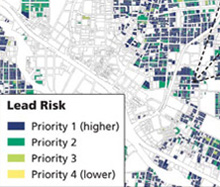
New tech on the block. GIS technology can help public health
officials pinpoint the worst environmental health hazards on a house-by-house
basis. Here, researchers mapped expected lead exposures in Durham,
North Carolina.
(Graphic: Children’s Environmental Health Initiative / Inset: Chris Reuther
/ EHP)
Detroit's Healthy Environments Partnership is an example of a CBPR endeavor.
Academic researchers from the University of Michigan are working directly with
several community groups and health service providers to examine the contributions
of the physical and social environments to both ethnic and socioeconomic disparities
in risk factors for cardiovascular disease among the adult population of Detroit.
Part of the partnership's wide-ranging data collection involves assessing aspects
of the built environment: housing conditions, sidewalk conditions, land use,
concentrations of airborne particulate matter, and access to grocery stores,
parks, and recreation areas.
Data have been gathered in three demographically diverse Detroit neighborhoods
that were initially selected because they were anticipated to vary in their
concentrations of airborne particulate matter. Air quality monitoring confirmed
this differential exposure. The researchers also surveyed neighborhood residents,
collected blood and saliva samples to assess physiological indicators of cardiovascular
risk and stress, and sent observers into the neighborhoods to evaluate the built
and social environments in each area.
Although the group is still analyzing the data, principal investigator Amy
Schulz, a research associate professor of health behavior and health education
at the University of Michigan School of Public Health, says they are seeing
trends suggestive of variations in both cardiovascular disease risk factors
and protective factors that play out for different racial and socioeconomic
groups across areas of the city. For example, they have noted variations in
dietary intakes of fruits and vegetables in population groups within the city,
and intend to analyze whether conditions in the built environments of the neighborhoods
can predict those variations.
Residents of the Detroit neighborhoods being studied have been involved at
all stages of the project, including helping to design the survey as well as
collect and analyze the data. "They are extremely knowledgeable about the
research that has been conducted," says Schulz, "and understand quite
well the results that we are seeing and their implications for the community,
because they have been so integrally involved every step of the way."
Also, says Schulz, community involvement contributes to a very rich analysis
whose results are more likely to lead to change. "It's really important
for us to have good information about the impact of the built environment and
the social environment on health, but it's clear that information alone is not
going to create change," she says. "Engaging community members in
processes begins to build community mobilization efforts for change."
Positive changes to the built environment that help reduce health disparities
can and do emerge from these partnerships. One such success story is San Diego's
Environmental Health Coalition (EHC), a 25-year-old nonprofit organization,
funded largely by a grant from the U.S. Department of Housing and Urban Development
(HUD) through the Community Environmental Health Resource Center. This Washington,
DC, group helps community organizations develop their capacity to document environmental
health hazards in substandard housing and to pursue effective organizing and
advocacy strategies for corrective and preventive action [for more information,
see "Community Environmental Health Resource Center," p. A303 this
issue]. The EHC works with university researchers, government agencies, and
community members to address toxic pollution, land use issues, and substandard
housing conditions in San Diego's low-income communities of color.
Much of that effort has focused on the Barrio Logan, a low-income Latino community
plagued by poor air quality due to heavy diesel truck traffic from a major regional
freeway dissecting the community, and a troubling mix of industries and residences
in close proximity to one another. Armed with results of an informal community
health survey that showed disturbing levels of asthma and other respiratory
problems, the group convinced the California Air Resources Board to begin monitoring
air quality in the community. Since then, says EHC research director Joy Williams,
"We've gotten the city of San Diego to agree to reroute truck traffic around
the community and not through it - one solution to the problem of diesel exhaust
in the community. EHC and the community are also working on changes to land
use and zoning that will reduce the number of warehouses and industries that
generate diesel truck traffic in residential areas."
The air monitoring also led to a direct intervention to help a family in distress.
The group had identified a metal-plating shop on a residential street in Barrio
Logan as a potential hazard, and asked for air samples to be collected in the
immediate vicinity. Regulators previously had believed that an operation of
that size that was basically in compliance would not pose much of a hazard.
However, once they sampled the air, they found high levels of emissions such
as chromium-6, a highly toxic air pollutant, at the houses next door and across
the street, says Williams. It turned out that one family living next door had
a son with poorly controlled asthma. Ultimately, the metal-plating shop was
forced to close (although many businesses in similar circumstances simply relocate),
reportedly leading directly to dramatic improvements in the boy's health. The
EHC continues to make such unhealthful mixed land uses a priority in its activities.
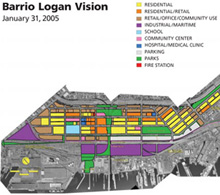
Envisioning a healthier community. The Environmental Health Coalition
is working with Barrio Logan, a low-income Latino community in San Diego, California,
to map out a plan for future land uses to help eradicate hazards and improve
health.
(Graphic: Environmental Health Coalition)
Housing Developments
Housing is perhaps the ultimate nexus between the built environment and health
disparities, and it has been the focus of much recent research and intervention
activity looking at new approaches to old problems. The intimate connection
between housing and health has been well known for more than a century - Florence
Nightingale once wrote, "The connection between health and the dwelling
of the population is one of the most important that exists." But today
there is renewed interest in discovering the complex pathways connecting housing
factors, neighborhood factors, social factors, adverse health outcomes, and
disproportionate disease burden in poor and ethnic minority communities - particularly
with respect to skyrocketing rates of chronic diseases such as asthma, obesity,
and diabetes.
That renewed interest is being manifested at the national and international
levels, as well as in the form of grassroots community action. In late 2004,
the World Health Organization convened its 2nd International Housing and Health
Symposium at Vilnius, Lithuania, a conference designed to review the existing
scientific evidence on housing and health relationships, and assess needs for
further research. In what may prove to be a development with wide-ranging global
impact, the symposium generated the Vilnius Declaration, in which 250 scientists
and officials representing 24 countries committed themselves "to taking
action to ensure that health and environmental dimensions are placed at the
core of all housing policies (from housing construction and rehabilitation plans,
programmes and policies to the use of adequate building materials) and that
healthy conditions are ensured and maintained in the existing housing stock."
In January 2005, indoor environmental quality took center stage at the Surgeon
General's Workshop on Healthy Indoor Environment. The two-day gathering of more
than 300 experts from government, academia, the building sciences industry,
and public interest groups focused on increasing attention to the issue of indoor
air pollution, with the surgeon general and other participants calling for action
to improve the health of Americans by improving indoor environments.
At the local level, two of the many CBPR projects in progress around the nation
demonstrate the multifaceted, collaborative approach being taken toward not
only characterizing housing and health pathways, but designing, implementing,
and evaluating interventions as well. Both have come about in response to the
high prevalence of asthma in low-income urban communities, with a special focus
on improving the health and housing conditions of public housing residents.
Boston's Healthy Public Housing Initiative (HPHI) is a collaboration among
public housing tenants' right groups, the Committee for Boston Public Housing,
the Peregrine Energy Group, and several area universities and city agencies.
The collaboration has produced guidance for builders, architects, and others
on ways to make both new construction and existing housing healthier. Participants
are currently engaged in a four-year project to assess the effectiveness of
HPHI asthma intervention programs in three public housing developments. The
interventions include installation of air filters, purchase of new mattresses,
heavy-duty cleaning, integrated pest management, family education on controlling
asthma triggers, and installation of building systems upgrades and modifications.
The group published a study in the 7 December 2004 edition of the online journal
Environmental Health: A Global Access Science Source reporting the results of
a detailed baseline evaluation of 78 asthmatic children living in the three
public housing developments. Among other findings, the study showed that many
of the children, although they had access to primary care physicians, were not
receiving care according to professional asthma management guidelines, which
include recommended medications, monitoring practices and equipment, and other
measures. Also, exposure to violence, which has been related to exacerbation
of asthma symptoms, was a significant problem. In one development where a series
of murders had taken place during the study period, 60% of the children were
never allowed outside to play.
Add those factors to substandard housing, high concentrations of local ambient
air pollution, and other negative aspects of neighborhood built environments,
and it starts to become clear why the prevalence and incidence of asthma has
risen so sharply and disproportionately among low-income minority urban children.
The study report concluded, "Given the elevated prevalence of multiple
risk factors, coordinated improvements in the social environment, the built
environment, and in medical management would likely yield the greatest health
benefits in this high-risk population."
A CBPR project currently under way in Seattle known as the High Point Healthy
Homes and Community Project is taking full advantage of a unique opportunity
to simultaneously address built environment issues in the public housing context
and gain useful knowledge about how comprehensive interventions can be used
to improve the health and well-being of residents. The Seattle Housing Authority
is in the process of reconstructing its public housing stock, to replace old,
deteriorating structures with town homes. One of the sites being updated is
High Point, formerly a 716-unit development, which is now being rebuilt as a
1,600-unit mixed-income community.
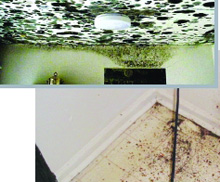
It came from within. Some of the worst home health hazards, such
as the black mold crawling across the ceiling of an apartment (upper left) and
the cockroach droppings blanketing the floor behind a refrigerator, arise inside
homes that are poorly maintained or designed. Indoor mold and cockroach antigens
have both been associated with worsened asthma and other adverse health effects.
(Photo: Samuel Arbes / NIEHS)
The High Point Healthy Homes and Community Project is taking a multilevel approach
to designing a public housing development to be a healthy, sustainable community.
Developers are thoughtfully addressing a range of considerations, from design
issues such as layout, walkability, and watershed protection, to the use of
construction materials and practices that enhance indoor environmental quality.
This project of the local public health department, housing authority, social
service providers, public housing residents, and the University of Washington,
with funding from the NIEHS and HUD, is paying particular attention to the needs
of families affected by asthma.
"At the individual housing unit level, we made an estimate of the number
of families living in High Point affected by asthma, and are now building specially
enhanced units which will minimize exposure to asthma triggers by improving
the indoor environmental quality," says James Krieger, principal investigator
on the NIEHS-funded component of the project, who is an epidemiologist with
the Seattle-King County Department of Public Health and a clinical associate
professor of medicine and health services at the University of Washington. (Tim
Takaro, also at the University of Washington, led the HUD-funded component.)
Thirty-five "Breathe Easy" demonstration homes will feature hardwood
flooring (instead of carpeting, which can outgas and cause respiratory problems)
and enhanced ventilation systems, weatherization, and insulation to minimize
humidity and moisture intrusion, costing an additional 3-4%, or roughly $5,000,
more than the development's standard units (which will also go well beyond building
code requirements in several specifications).
Researchers will follow the families for a year before they move into the
units to establish a baseline assessment of their asthma status, and then continue
to follow them for a year after they move into their new homes, which are currently
under construction (the first families are scheduled to move in in fall 2006).
"This will be one of the first studies designed as an intervention of people
moving into [better]-quality housing while having a health outcome that's clearly
measurable like asthma, to see what the health impact is," says Krieger.
The Seattle Housing Authority and its organizational partner, Neighborhood
House, have also actively sought residents' input in the design of the new community.
It is slated to include walking paths and trails, mini-parks and one larger
park, a grocery store, a public library, and a community health center, in hopes
that these amenities will provide a built environment more conducive to health
and social interaction. A community-based education initiative is also under
way, using trained teams of community residents called project action teams
to teach their neighbors about basic principles of how to keep their homes and
community healthy.
Krieger says they will conduct before-and-after community surveys assessing
people's physical activity, social cohesion, and other factors. "Hopefully,
we'll be able to empirically test the whole notion that a change in the built
environment will change health behaviors and increase community cohesion and
social capital," he says. "There's limited empiric data out there
on that now." [For information on another innovative Seattle housing project,
see "Growing Green Communities," p. A300 this issue.]
David Jacobs, a HUD housing expert, sees wide-ranging potential in projects
that quantify such benefits. "If we are able to fully value those types
of investments in houses that produce positive health outcomes," he says,
"then we can end the cost-shifting that causes both higher medical bills
and higher housing costs. Right now, the benefits of health investments in housing
or communities are largely hidden, with avoidable - and usually much higher
- costs being absorbed by the medical care sector, after the harm has already
been done."
The Search for Solutions, Large and Small
Public health and urban planning, sectors that once were closely aligned,
have drifted apart over the decades, evolving into professional specialties
with too few opportunities to collaborate and little mutual influence, some
say. Many practitioners seeking solutions to the festering problems of health
disparities and built environment inequities see reconnection of the two fields
as a critical goal.
Jason Corburn, codirector of the Center for Occupational and Environmental
Health at Hunter College of the City University of New York, strongly advocates
recoupling the fields so as to build health considerations into land use, zoning,
community design, and other urban planning decisions that to a large extent
shape the long-term nature of the built environment. "Too often we're quantifying
housing quality or some aspect of the built environment," says Corburn,
"but we're not looking historically and at the present time at how these
urban planning and land use decisions are being made - who's involved, what
are the processes, who has access to the information. Without that kind of political
analysis of the public decision making behind it, I think we're missing a big
piece of the built environment-health disparities puzzle."
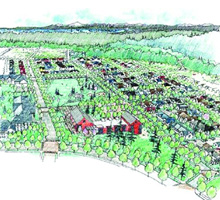
Making houses into healthy homes. The High Point Healthy Homes
and Community Project in Seattle is employing a new paradigm for public housing:
design with health and sustainability in mind.
(Graphic: Seattle Housing Authority)
Corburn has helped initiate and manage the development of a health impact assessment
process in San Francisco, which is rezoning several neighborhoods in its Mission
District. Corburn is working with the city's public health department and a
group of nearly 40 stakeholders including tenants' rights organizations, business
owners, and other community organizations. Their mission is first to define
the community's ideas of the physical and social characteristics of a healthy
neighborhood, and then to construct a plan to incorporate those elements as
distinct goals of the rezoning process. "The health impact assessment process
in San Francisco is an experiment," Corburn says, "but I think it's
very promising. This kind of approach holds the potential to reconstruct the
boundaries of environmental health."
Prevention Institute, a nonprofit group based in Oakland, California, works
with governments, communities, and organizations to establish prevention-oriented
health programs and policies. This institute is actively promoting increased
participation by public health practitioners in the built environment decision-making
process. To help foster greater understanding of the potential role public health
can play in improving health outcomes and reducing disparities by altering the
built environment, the group recently released a report, The Built Environment
and Health: 11 Profiles of Neighborhood Transformation, that highlights local
success stories across the country. The profiles include inner-city yard lead
abatement efforts in Boston, separate successful drives to close nuisance liquor
stores in south Los Angeles and open a grocery store in a deprived community
in Rochester, New York, and programs that have brought amenities such as jogging
paths, bike and walking trails, mural arts, and community gardens to other municipalities.
All of the interventions have involved collaborations among community groups,
local governments, and public health officials, and have been aimed at reducing
health disparities and improving the health of residents of low-income communities.
One of the Prevention Institute's projects to help communities address health
disparities is called THRIVE (Community Tool for Health and Resilience in Vulnerable
Environments). THRIVE is a toolkit designed to aid communities in comprehensively
assessing their conditions along a scale of risk to resiliency. Executive director
Larry Cohen illustrates the concept: "When we think about risk, a street
that does not have sidewalks or a separate place for bicyclists is going to
be far more dangerous than what we call a 'complete street,' which functions
for public transportation, for automobiles, for pedestrians, and for bicyclists.
Obviously, the first street is going to promote risk, with far more likelihood
of automobile crashes and air quality health-related issues, and the second
is going to promote resiliency, with more opportunities for physical activity.
So a risk can be ameliorated and create a community which will be more resilient."
The THRIVE toolkit describes 20 community factors within four interrelated
clusters: built environment, social capital (which includes societal factors
such as social cohesion and trust, civic engagement and participation, and broadly
shared beliefs and standards of behavior), services and institutions, and structural
factors, with a depiction of risk and resilience for each factor. "This
is about looking broadly at the community and creating environments in communities
where people want to live, where they can be healthy and safe," says program
manager Manal Aboelata. This can have tremendous impact on not just physical
health but also mental health. The toolkit has been successfully pilot-tested
in both rural and urban communities, and is currently awaiting final approval
from federal funding agencies prior to being available nationally.
A Concrete Future?
Can this new paradigm within the environmental health sciences - with its
multidisciplinary, systems-level approach to interactions between the built
environment and health disparities - actually help to solve some of these long-standing,
large-scale problems? Even with the latest scientific knowledge and the enthusiastic
participation of a multiplicity of stakeholders, can profound, lasting change
realistically be expected to follow? Although there are many encouraging trends,
the challenges are formidable and complex, and observers active in the field
understand that their campaign will be long, with no assurance of victory.
Carlos Mendes de Leon, an epidemiologist at Rush University Medical Center
in Chicago, is investigating the biological and environmental mechanisms by
which socioeconomic deprivation leads to disability in older people. His comments
on the potential for broad improvements at the societal scale are representative
of those heard from many researchers who are determined to soldier on: "At
this moment, it's hard to see this kind of knowledge and understanding of the
built environment and health disparities having very concrete ramifications
for public policy and medical interventions," he says.
"But at the same time," he adds, "we still have to build up
the knowledge base so that when conditions change in the broader political sphere,
we can point to concrete evidence and concrete strategies that may make an effect."
Yet there have been many important achievements that demonstrate the potential
power of these ideas. For example, the number of both lead-poisoned children
and houses with lead-based paint have been reduced over the past decade thanks
to concerted action by policy makers and community members. Many diseases that
still plague the developing world, such as typhoid and cholera, have been largely
eradicated in the United States due in part to improvements in housing density,
ventilation, and reliable community water supplies. Learning from these examples
should be a first step toward restoring the connections between environmental
health, housing, urban planning, and the built environment so that many of the
diseases that still plague us today can also be wiped from our lives.

